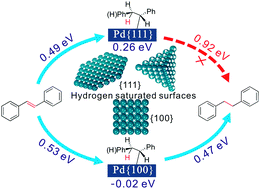Origin of the facet dependence in the hydrogenation catalysis of olefins: experiment and theory†
Abstract
Shape-controlled Pd nanocrystals are used as model catalysts to demonstrate facet-dependent catalysis in the hydrogenation of olefins. The close packed Pd{111} shows high catalytic activity for styrene but not for trans-stilbene. However, the open Pd{100} facets hydrogenate both olefins. DFT calculations reveal that the hydrogenation reactivity critically depends on the stability of half-hydrogenated intermediates.


 Please wait while we load your content...
Please wait while we load your content...